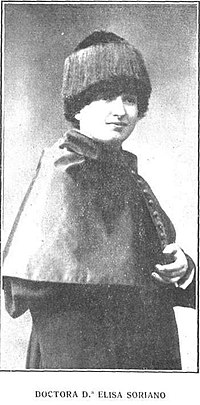Elisa Soriano Fisher
She is considered a leading figure of universal suffrage and associative and intellectual feminism of the 1920s and 1930s, until the beginning of the Spanish Civil War.
Despite the scarcity of information available about her childhood, it is known that her mother was Enriqueta Fisher, who died before Elisa was 5 years old and that her father was José Soriano Surroca (1865-1938), a prominent gynecologist and academic from Madrid.
Then she continued her studies at the General and Technical Institute of Guadalajara and later at the Escuela Normal Superior de Maestras, where in 1912 she completed a Higher Degree in Teaching with an outstanding qualification.
[6][5] Elisa Soriano started a double professional career, combining ophthalmology in various public institutions and in a private consultation, with the teaching of Hygiene, Physiology and Anatomy at the Escuela Normal Central de Maestras.
Even in Redención, one of the first Spanish feminist publications, they picked up the story, by saying that she had the honour of being the first woman to hold an official position at the Hospital.
In addition, the director of the publication El Monitor Sanitario, Luis Ortega Morejón, wrote a biography about her, in which he asserted that Elisa was the one who had provided hin with the data and that she was the first woman to appear in his journal thanks to: “her capacity, preparation, intelligence and energy to always succeed in difficult missions”.
[6] In 1927 Elisa Soriano, who was already part of the Asociación Internacional de Médicas (female doctors association), was named by the famous doctor and feminist Kate Campbell Hurd-Mead president of the Medical Women International Association (MWIA), in an article she wrote after a visit to Spain.
In addition, Soriano approved the public examinations and obtained a place in the medical corps of the Spanish Marina Civil, becoming the first woman who landed to carry out this profession.
[6][1][5] The first piece of information that was published in “El Globo” press on December 8, under the title “The Force that is born” was a manifesto that ends with these words: “Woman’s redemption, perfection of societies, elevation of humanity”.
Other ANME activists were Benita Asas, Dolores Velasco and Julia Peguero who were led by María Espinosa de los Monteros.
Two years later, specifically at the Great Meeting of the National Association of Spanish Women, Soriano was selected as one of the permanent members of the new board of directors.
She was one of the most outstanding personalities of that time in Madrid, since she had a great influence on many women who took part in several key moments of the Spanish feminism.
The JUF's statutes were published in the magazine Redención, and included the main objective of the association: “That women who follow higher education could obtain the same positions as men when they deserve them for their intelligence”.
[1][5][6] Her constant struggle for equality led her in June 1920 to be the Spanish delegate for the University Youth of Madrid at the conference that took place in Geneva on the International Alliance for the Suffrage of Women's initiative.
Her presence there was not strange at all since Dr. Soriano was considered one of the icons of Spanish feminism and was always in places where she believed it was necessary to represent women's aspirations.
They emphasized in that speech that the organization's main objective was to protect those women dedicated to university studies, and this was done by granting money to them.
At this event, she treated subjects such as the practices of mixing or separating students of both sexes; the need to put aside professional ideals, as well as political and religious passions.
The merits of the association were highlighted, particularly those of María Espinosa de los Monteros, who, guided by the cause of feminism, contributed to the creation of the awards.
Elisa Soriano participated, on behalf of the JUF, in the tribute to María Guerrero and Fernando Díaz de Mendoza.
[6] Although the activities of the JUF were fading, the popularity of Elisa Soriano was rising to the point that Augusto Martínez Olmedilla dedicated her a publication in the collection La Novela de Hoy in 1922.
A year later, Soriano was appointed delegate by the Ministry of Public Instruction to represent Spain in the Conference of Bologna.
This relationship probably began when Fisher offered Nelker her support after reading an article of her against the abandonment of children and the precarious conditions they had suffered.
Before the war, both had worked as appointed counselors for the republican Government in the National Council of Health and Public Assistance.
